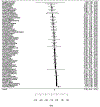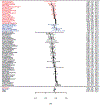Association between medical academic genealogy and publication outcome: impact of unconscious bias on scientific objectivity
- PMID: 30673844
- PMCID: PMC6452899
- DOI: 10.1007/s00701-019-03804-9
Association between medical academic genealogy and publication outcome: impact of unconscious bias on scientific objectivity
Abstract
Background: Our previous studies suggest that the training history of an investigator, termed "medical academic genealogy", influences the outcomes of that investigator's research. Here, we use meta-analysis and quantitative statistical modeling to determine whether such effects contribute to systematic bias in published conclusions.
Methods: A total of 108 articles were identified through a comprehensive search of the high-grade glioma (HGG) surgical resection literature. Analysis was performed on the 70 articles with sufficient data for meta-analysis. Pooled estimates were generated for key academic genealogies. Monte Carlo simulations were performed to determine whether the effects attributed to genealogy alone can arise due to chance alone.
Results: Meta-analysis of the HGG literature without consideration for academic medical genealogy revealed that gross total resection (GTR) was associated with a significant decrease in the odds ratio (OR) for the hazard of death after surgery for both anaplastic astrocytoma (AA) and glioblastoma (AA: log [OR] = - 0.04, 95% CI [- 0.07 to - 0.01]; glioblastoma log [OR] = - 0.36, 95% CI [- 0.44 to - 0.29]). For the glioblastoma literature, meta-analysis of articles contributed by members of a genealogy consisting of mostly radiation oncologists revealed no reduction in the hazard of death after GTR [log [OR] = - 0.16, 95% CI [- 0.41 to 0.09]. In contrast, meta-analysis of published articles contributed by members of a genealogy consisting of mostly neurosurgeons revealed that GTR was associated with a significant reduction in the hazard of death [log [OR] = - 0.29, 95% CI [- 0.40 to 0.18]. Monte Carlo simulation revealed that the observed discrepancy between the articles contributed by the members of these two genealogies was unlikely to arise by chance alone (p < 0.006).
Conclusions: Meta-analysis of articles contributed by authors belonging to the different medical academic genealogies yielded distinct and contradictory pooled point-estimates, suggesting that genealogy contributes to systematic bias in the published literature.
Keywords: Brain tumor; Medical academic genealogy; Meta-analysis; Scientific objectivity.
Conflict of interest statement
CONFLICT OF INTEREST
All authors certify that they have no affiliations with or involvement in any organization or entity with any financial interest (such as honoraria; educational grants; participation in speakers’ bureaus; membership, employment, consultancies, stock ownership, or other equity interest; and expert testimony or patent-licensing arrangements), or non-financial interest (such as personal or professional relationships, affiliations, knowledge or beliefs) in the subject matter or materials discussed in this manuscript.
Figures




Comment in
-
Are other scientific genealogies reporting alternative facts?Acta Neurochir (Wien). 2019 Feb;161(2):213-215. doi: 10.1007/s00701-019-03805-8. Epub 2019 Jan 16. Acta Neurochir (Wien). 2019. PMID: 30648213 No abstract available.
Similar articles
-
Impact of medical academic genealogy on publication patterns: An analysis of the literature for surgical resection in brain tumor patients.Ann Neurol. 2016 Feb;79(2):169-77. doi: 10.1002/ana.24569. Epub 2016 Jan 4. Ann Neurol. 2016. PMID: 26727354
-
Coevolution of Peer-Reviewed Literature and Clinical Practice in High-Grade Glioma Resection.World Neurosurg. 2016 Dec;96:237-241. doi: 10.1016/j.wneu.2016.07.105. Epub 2016 Aug 12. World Neurosurg. 2016. PMID: 27523637
-
'Journal Bias' in peer-reviewed literature: an analysis of the surgical high-grade glioma literature.J Neurol Neurosurg Psychiatry. 2016 Nov;87(11):1248-1250. doi: 10.1136/jnnp-2015-312998. Epub 2016 Apr 26. J Neurol Neurosurg Psychiatry. 2016. PMID: 27118036
-
Biopsy Versus Subtotal Versus Gross Total Resection in Patients with Low-Grade Glioma: A Systematic Review and Meta-Analysis.World Neurosurg. 2018 Dec;120:e762-e775. doi: 10.1016/j.wneu.2018.08.163. Epub 2018 Aug 30. World Neurosurg. 2018. PMID: 30172972
-
Survival Benefit of Maximal Resection for Glioblastoma Reoperation in the Temozolomide Era: A Meta-Analysis.World Neurosurg. 2019 Jul;127:31-37. doi: 10.1016/j.wneu.2019.03.250. Epub 2019 Apr 1. World Neurosurg. 2019. PMID: 30947000 Review.
Cited by
-
The impact of authors' medical specialty on publication patterns and published results of adjuvant radiotherapy for WHO grade 2 meningiomas-a systematic review.Acta Neurochir (Wien). 2021 Sep;163(9):2459-2464. doi: 10.1007/s00701-021-04797-0. Epub 2021 Mar 29. Acta Neurochir (Wien). 2021. PMID: 33779837 Free PMC article.
References
-
- Academic Genealogy Wiki (2014) Available at: http://phdtree.org/. Accessed on 7 October 2015
-
- Barr AH Jr (1936) Cubism and Abstract Art. Belknap Press, Cambridge, MA
-
- Butowski N, Lamborn KR, Berger MS, Prados MD, Chang SM (2007) Historical controls for phase II surgically based trials requiring gross total resection of glioblastoma multiforme. J Neurooncol 85(1):87–94 - PubMed
-
- Carico C, Nuño M, Mukherjee D, Elramsisy A, Dantis J, Hu J, Rudnick J, Yu JS, Black KL, Bannykh SI, Patil CG (2012) Loss of PTEN is not associated with poor survival in newly diagnosed glioblastoma patients of the temozolomide era. PLoS One 7(3):e33684. doi: 10.1371/journal.pone.0033684 - DOI - PMC - PubMed
Publication types
MeSH terms
Grants and funding
LinkOut - more resources
Full Text Sources

